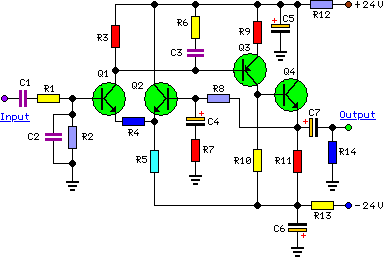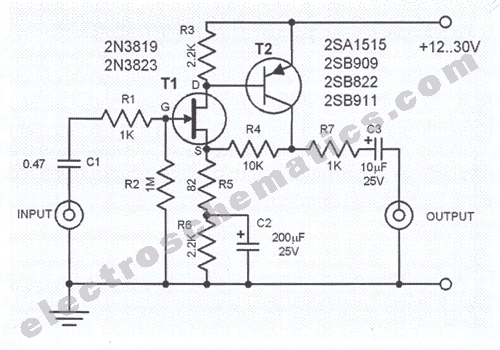
RIAA phono preamplifier NE5532

If you still like to spin vinyl and features a turntable, but the amplifier has no more input for a turntable is below a switching solution. We used a NE5532 to a simple stereo RIAA phono preamp to build. The output can directly to the AUX or line-in of the amplifier. There is also a board layout is available. To hum and other disturbances to avoid the populated board in a fully dense aluminum or tin casing be installed. For the input and output can be used chinch chassis parts. If the power is FDA-approved symmetric mini. More: Parts List R1, R10 = 470 ohm R2, R8 = 68k ohm R3, R9 = 47k ohm R4, R7 = 470K ohms R5, R6 = 47 ohms R11, R12 = 1k ohm C1, C8 = 47µF 35V C2, C7 = 100pF ceramic or styroflex C3, C6 = 1nF MKT C4, C5 = 4.7 nF MKT C9, C10 = 470µF 35V A1 = NE5532
The described circuit is a stereo RIAA phono preamplifier designed to interface a turntable with an amplifier that lacks a dedicated phono input. The NE5532 operational amplifier is utilized for its low noise and high performance, making it suitable for audio applications.
The circuit configuration includes several resistors and capacitors that form the RIAA equalization network, which is essential for accurate playback of vinyl records. The resistor values are strategically selected to ensure proper gain and frequency response. For instance, R2 and R8 are 68k ohms, which are typically used in the input stage to set the input impedance for the turntable, while R4 and R7 at 470k ohms provide the necessary feedback for the NE5532.
Capacitors C1 and C8, each rated at 47µF, are used for power supply decoupling, ensuring stable operation of the op-amp by filtering out voltage fluctuations. The smaller capacitors C2 and C7, at 100pF, are chosen for high-frequency response, while C3 and C6, at 1nF, and C4 and C5, at 4.7nF, contribute to the RIAA equalization curve, shaping the frequency response for optimal playback of vinyl records.
To minimize interference and hum, it is recommended to enclose the populated board in a dense aluminum or tin casing, which acts as a shield against electromagnetic interference. The use of RCA (chinch) chassis parts for the input and output connections is also suggested to maintain signal integrity and ensure compatibility with standard audio equipment.
The power supply for the circuit should be a FDA-approved symmetric mini supply, ensuring that the operational amplifier receives the appropriate voltage levels for optimal performance. The overall design emphasizes not only functionality but also the importance of layout and shielding in audio applications to enhance sound quality and reduce unwanted noise.If you still like to spin vinyl and features a turntable, but the amplifier has no more input for a turntable is below a switching solution. We used a NE5532 to a simple stereo RIAA phono preamp to build. The output can directly to the AUX or line-in of the amplifier. There is also a board layout is available. To hum and other disturbances to avoid the populated board in a fully dense aluminum or tin casing be installed.
For the input and output can be used chinch chassis parts. If the power is FDA-approved symmetric mini. Parts List R1, R10 = 470 ohm R2, R8 = 68k ohm R3, R9 = 47k ohm R4, R7 = 470K ohms R5, R6 = 47 ohms R11, R12 = 1k ohm C1, C8 = 47?F 35V C2, C7 = 100pF ceramic or styroflex C3, C6 = 1nF MKT C4, C5 = 4.7 nF MKT C9, C10 = 470?F 35V A1 = NE5532 🔗 External reference
The described circuit is a stereo RIAA phono preamplifier designed to interface a turntable with an amplifier that lacks a dedicated phono input. The NE5532 operational amplifier is utilized for its low noise and high performance, making it suitable for audio applications.
The circuit configuration includes several resistors and capacitors that form the RIAA equalization network, which is essential for accurate playback of vinyl records. The resistor values are strategically selected to ensure proper gain and frequency response. For instance, R2 and R8 are 68k ohms, which are typically used in the input stage to set the input impedance for the turntable, while R4 and R7 at 470k ohms provide the necessary feedback for the NE5532.
Capacitors C1 and C8, each rated at 47µF, are used for power supply decoupling, ensuring stable operation of the op-amp by filtering out voltage fluctuations. The smaller capacitors C2 and C7, at 100pF, are chosen for high-frequency response, while C3 and C6, at 1nF, and C4 and C5, at 4.7nF, contribute to the RIAA equalization curve, shaping the frequency response for optimal playback of vinyl records.
To minimize interference and hum, it is recommended to enclose the populated board in a dense aluminum or tin casing, which acts as a shield against electromagnetic interference. The use of RCA (chinch) chassis parts for the input and output connections is also suggested to maintain signal integrity and ensure compatibility with standard audio equipment.
The power supply for the circuit should be a FDA-approved symmetric mini supply, ensuring that the operational amplifier receives the appropriate voltage levels for optimal performance. The overall design emphasizes not only functionality but also the importance of layout and shielding in audio applications to enhance sound quality and reduce unwanted noise.If you still like to spin vinyl and features a turntable, but the amplifier has no more input for a turntable is below a switching solution. We used a NE5532 to a simple stereo RIAA phono preamp to build. The output can directly to the AUX or line-in of the amplifier. There is also a board layout is available. To hum and other disturbances to avoid the populated board in a fully dense aluminum or tin casing be installed.
For the input and output can be used chinch chassis parts. If the power is FDA-approved symmetric mini. Parts List R1, R10 = 470 ohm R2, R8 = 68k ohm R3, R9 = 47k ohm R4, R7 = 470K ohms R5, R6 = 47 ohms R11, R12 = 1k ohm C1, C8 = 47?F 35V C2, C7 = 100pF ceramic or styroflex C3, C6 = 1nF MKT C4, C5 = 4.7 nF MKT C9, C10 = 470?F 35V A1 = NE5532 🔗 External reference





